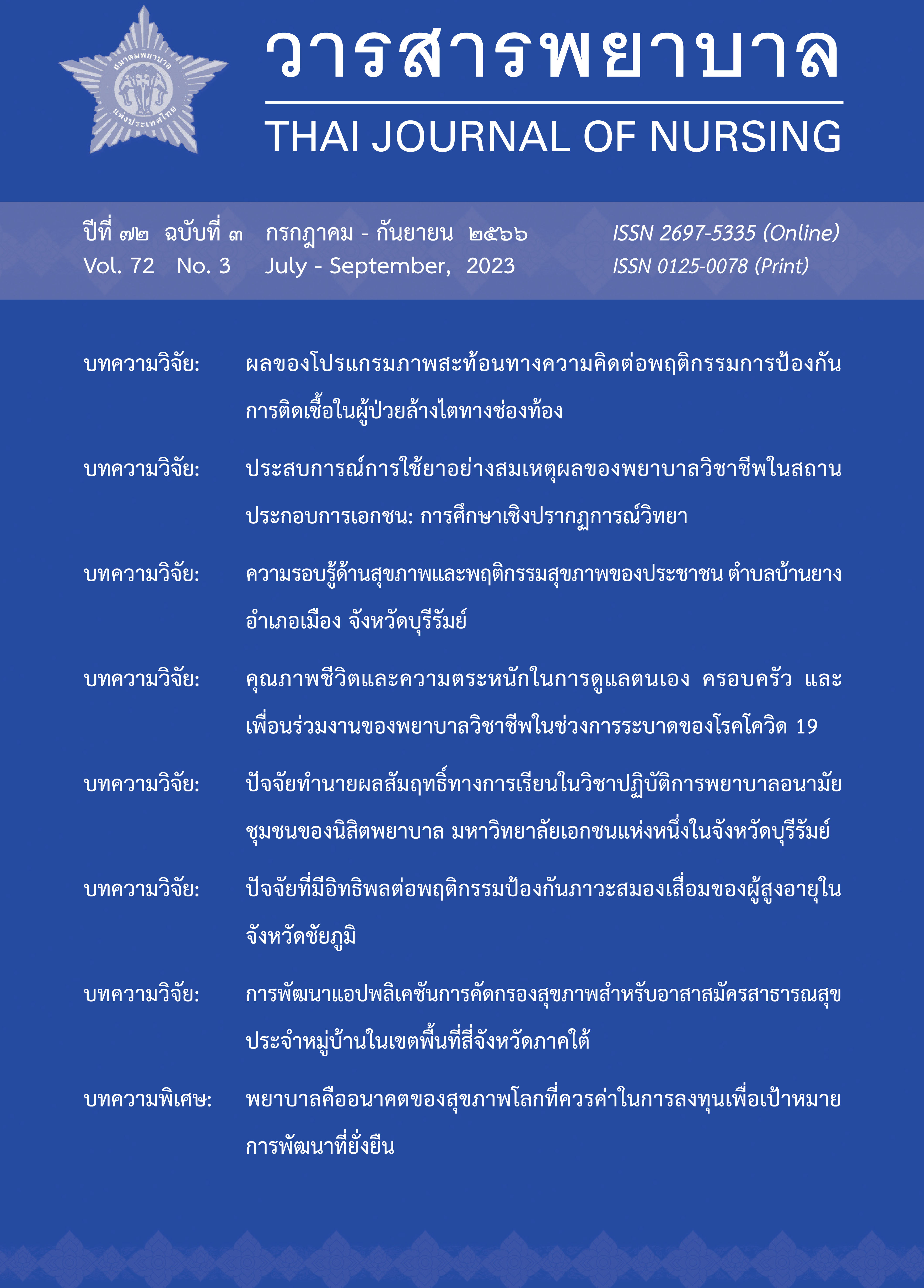The effect of an illness representation program on infection-preventive behavior among patients with Continuous Ambulatory Peritoneal Dialysis
Main Article Content
Abstract
This quasi-experimental research aimed at determining effect of an illness representation program on infection-preventive behavior among patients with Continuous Ambulatory Peritoneal Dialysis (CAPD). A sample of 50 patients with CAPD at home, was selected using the purposive sampling method. They were equally divided into the comparative and experimental groups. Research instruments included an illness representation program and infection-preventive behavior questionnaire. Data were analyzed using descriptive statistics, Chi-square test, and t-test. The results revealed that implementation of an illness representation program caused higher infection-preventive behavior in patients with CAPD. As the results that after experiment, infection-preventive behavior of patients in the experimental group were significantly higher than before experiment and higher than those in the comparative group at p < .05.
Article Details

This work is licensed under a Creative Commons Attribution-NonCommercial-NoDerivatives 4.0 International License.
References
กมลทิพย์ วิจิตรสุนทรกุล. (บ.ก.). (2565). ระบาดวิทยาและการทบทวนมาตรการป้องกันโรคไตเรื้อรัง. กรมควบคุมโรค กระทรวงสาธารณสุข.
ดิศรา พสมัย. (2561). ปัจจัยที่มีความสัมพันธ์กับความล้มเหลวของการฟอกไตทางช่องท้องในการวางสายฟอกไตทางช่องท้อง ของโรงพยาบาลสันทราย. วารสารโรงพยาบาลนครพิงค์, 9(2), 1-13.
ประภากร ศรีสง่า และ นงลักษณ์ เมธากาญจนศักดิ์. (2565). ผลของโปรแกรมการสอนบนแนวคิดภาพสะท้อนทางความคิดผ่านแอปพลิเคชันไลน์ต่อผลลัพธ์ที่คัดสรรในผู้ป่วยโรคไตเรื้อรังระยะที่ 3 ที่มีอัตราการ
ทำงานของไตลดลงอย่างรวดเร็ว. วารสารพยาบาลศาสตร์และสุขภาพ, 45(1), 18-29.
แพรวพรรณ โกสินทร, อะเคื้อ อุณหะเลขกะ, และ นงเยาว์ เกษตร์ภิบาล. (2558). ผลของการเสริมสร้างพลังอำนาจต่อการปฏิบัติการป้องกันการติดเชื้อและอุบัติการณ์การติดเชื้อในผู้ป่วยล้างไตทางช่องท้องแบบต่อเนื่อง. พยาบาลสาร [ฉบับพิเศษ], 42, 1-12.
เลอลักษณ์ ไล้เลิศ. (2560). ผลของโปรแกรมสุขศึกษาโดยใช้ภาพตัวแทนความเจ็บป่วยต่อพฤติกรรมการปฏิบัติตัวและผลลัพธ์ทางคลินิกของผู้ป่วยโรคไตเรื้อรังที่ได้รับการฟอกเลือดด้วยเครื่องไตเทียม [วิทยานิพนธ์ปริญญามหาบัณฑิต ไม่ได้ตีพิมพ์]. มหาวิทยาลัยธรรมศาสตร์. doi:10.14457/TU.the.2017.688
วงศกร บุญกาญจน์. (2563). การติดเชื้อราในเยื่อบุช่องท้องในผู้ป่วยล้างไตทางช่องท้องอย่างต่อเนื่อง: ประสบการณ์ 10 ปี ในโรงพยาบาลมหาราชนครศรีธรรมราช. มหาราชนครศรีธรรมราชเวชสาร, 4(1), 97-107.
วราทิพย์ แก่นการ. (2558). การพยาบาลแบบองค์รวมผู้ป่วยล้างไตทางช่องท้อง: บทบาทท้าทายภายใต้นโยบาย PD First Policy. วารสารการพยาบาลและการดูแลสุขภาพ, 33(4), 6-14.
Donovan, S. H., Ward, S. E., Song, M. K., Heidrich, S. M., Gunnarsdottir, S., & Phillips, C. M. (2007). An update on the representational approach to patient education. Journal of Nursing Scholarship, 39(3), 259-265.
doi: 10.1111/j.1547-5069.2007.00178.x
Hewson, M. G. (1993). Patient education through teaching for conceptual change. Journal of General Internal Medicine, 8(7), 393-398. doi: 10.1007/BF02600081
Leventhal, H., Meyer, D., & Nerenz, D. (1980). The common sense representation of illness danger. In S. Rachman (Ed.), Medical Psychology (Vol II, pp.7-30). Pergamon Press.
Li, P. K. T., Chow, K. M., Cho, Y., Fan, S., Figueiredo, A. E., Harris, T., Kanjanabuch, T., Kim, Y. L., Madero, M., Malyszko, J., Mehrotra, R., Okpechi, I. G., Perl, J., Piraino, B., Runneger, N., Teitelbaum, I., Wong, J. K. W., Yu, X., & Johnson, D. W. (2022). ISPD peritonitis guideline recommendations: 2022 update on prevention and treatment. Peritoneal Dialysis International, 42(2), 110-153.
Rivera, E., Corte, C., DeVon, H. A., Collins, E. G., & Steffen, A. (2020). A systematic review of illness representation clusters in chronic conditions. Research in Nursing & Health, 43(3), 241-254. doi: 10.1002/nur.22013


